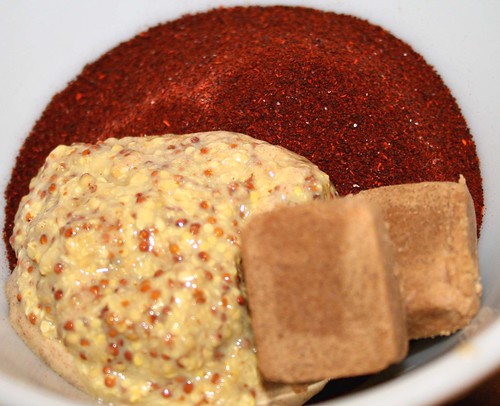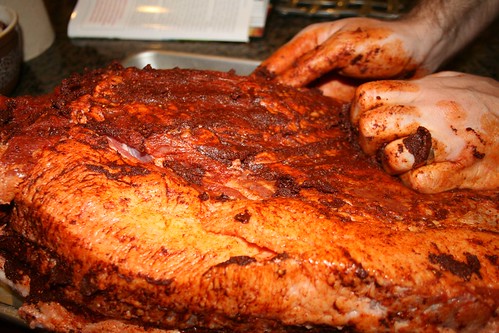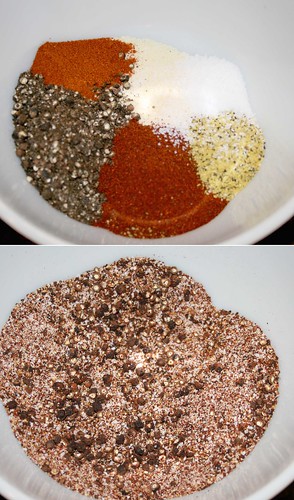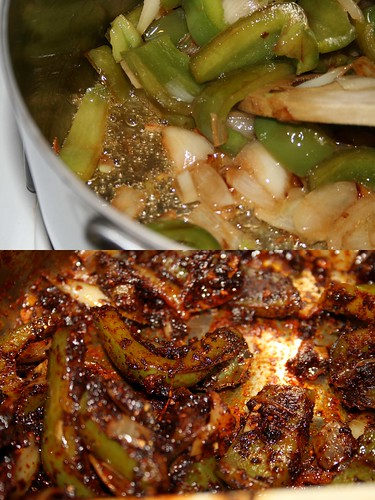When I first moved to Texas from Canada twelve years ago, I had a Canadian's conception of barbecue. Bbq is burgers. Hot dogs. On a day you're feeling fancy, bbq is steak.
In Texas, barbecue is only when you're using indirect heat, low and slow, over hours and hours to break down the meat. In Texas, brisket is the king of barbecue.
Brisket is a rather nasty cut of meat. It's tough. It's fatty. And it takes a damn long time to break down the fat.

Brisket is very high in collagen, a connective tissue that holds meat together. It takes a long time to break down collagen so that the meat is a nice consistency. If you do this at a normal meat-cooking temperature, by the time the collagen has broken down you'll have a brisket biscuit. Yuck. So instead, we cook the meat low and slow, to allow the collagen to break down. The real trick is to do this without drying out the meat too much. A good brisket harnesses indirect heat in the best possible way. As far as I'm concerned, brisket is quintessential barbecue. Cook it low (low temperature) and slow (long, loooong time on the bbq) and it will fall apart beautifully, and better than even the highest quality cuts of beef.
I have an old-standard brisket that I make pretty regularly. I will not be writing about that today. Rather, I recently cooked a modification of a new recipe for brisket, from Adam Perry Lang's new book, Serious Barbecue. Get yourself a decent sized brisket. Outside of Texas, you'll need to go to a butcher, and explain what you want. In Maryland I had to special order brisket. In San Diego, there is one place that cuts the briskets the way I want, Iowa Meat Farm. I like to do them big, up to 16 lbs. The bigger it is, the longer you can smoke it before it dries out. Certainly anything smaller than 10 lbs is too small to properly smoke. Get up early. If you're serving brisket for dinner, you'll need to be lighting the fire around 11 hours before you serve it (for us, around 7 a.m.). So get up, pull the brisket out of the fridge and then light the charcoal on your grill. While you wait for your grill to heat up, make the paste:
Get yourself a decent sized brisket. Outside of Texas, you'll need to go to a butcher, and explain what you want. In Maryland I had to special order brisket. In San Diego, there is one place that cuts the briskets the way I want, Iowa Meat Farm. I like to do them big, up to 16 lbs. The bigger it is, the longer you can smoke it before it dries out. Certainly anything smaller than 10 lbs is too small to properly smoke. Get up early. If you're serving brisket for dinner, you'll need to be lighting the fire around 11 hours before you serve it (for us, around 7 a.m.). So get up, pull the brisket out of the fridge and then light the charcoal on your grill. While you wait for your grill to heat up, make the paste:
5 tbsp ancho chile powder3 tbsp dijon mustard3 tbsp beef bouillon

Mix the ingredients into a nice, goopy paste (add a tiny bit of water to make it easier to rub if necessary). Now massage this into the brisket. I've read about massaging meat before, this is the first paste that I really felt like I really needed to work it in. Indeed, my wife asked me if I needed time alone with the brisket...

Tell me that doesn't look incredible!
Now, the next step is to make the seasoning:
1/4 cup garlic salt3 tbsp coarsely ground black pepper2 tbsp chili powder1 tbsp lemon pepper2 tsp kosher salt3/4 tsp cayenne pepper

Sprinkle that lovely stuff all over the meat. The paste will help it stick. Now take a breather, and leave the meat to warm up for an hour or so. Gives you enough time to make breakfast for your family. Try waffles.
Towards the end of the hour, move the charcoal over to one side of your grill. You don't want your brisket anywhere near that heat. You're going to have a pile of screaming hot coals on one side of the grill, and a brisket on the other. The real trick to bbq is judging how your grill holds the heat. How much charcoal you need to warm it up, how often you need to feed the fire.
Close your grill, and warm it up to 225 F. You want to hold it around 225 the entire cook. In the beginning and the end is the hardest. In the beginning, because you have a 16 lb heat sink that's absorbing heat, in the end because the fire is smothering itself in 12 hours of ashes. Now gently brush the brisket with canola oil, and place it on the grill, fat side up, away from the heat. You want indirect heat for your brisket. This is the magic of indirect heat.
Keep the grill closed as much as possible. When you open it, feed the fire as quickly as possible, and even don't open the lid fully to add charcoal. Each time you open it, you're letting precious heat out, and giving another 15 minutes to heat up the grill. Soak mesquite wood chips (really, you want mesquite for brisket) and add them every time you open it to add the mesquite flavor. And wait. And wait. And wait. You're gonna have that brisket on there basically all day. You've got time to read a book. Play video games. Play bocce with your kids. And prepare other dishes for dinner.
While you're waiting, you might as well make barbecue sauce:
1/2 cup canola oil5 garlic cloves, chopped1 onion, chopped1 green bell pepper, chopped2 tsp salt1/4 cup bourbon3 tbsp chili powder1 tbsp coarsely ground black pepper1/4 tsp allspice1/4 tsp cloves1 cup dark brown sugar2 cups water2 cups ketchup1/2 cup molasses1/2 cup dijon mustard1/2 cup apple cider vinegar2 tsp hot sauce (I used sriracha)1/2 cup apricot preserves1 jalapeno chile, grated1/2 Granny Smith apple, grated
Sautée the onions, garlic, pepper and salt in the oil until lightly browned and the onions are translucent. Pour in the bourbon. This is the best part, cause the whole kitchen will smell like bourbon while you reduce the sauce. After most of the bourbon has boiled off, add the spices, and sautée for a few more minutes. The whole kitchen will now smell absolutely ridiculously amazing.

And it'll start looking pretty ridiculously yummy, also. Cook for a few minutes, but this stage must come to an end. Add everything else. Boil for an hour or so to reduce the sauce, and adjust seasoning to your taste (if it were just for me, I'd dial up the heat a bit, but most of our guests don't like heat the way I do, so I left it as is).

When it cools a bit, run it through a blender, or work it a bit with your immersion blender.
Okay, back to the brisket. Over the 11-12 hours you cook it, it should darken. Even blacken.
Don't freak out. The blackening doesn't indicate burning of your brisket, just darkening of the spices on the outside of the brisket.

The magic of indirect heat will transmogrify your meat into a beautiful brisket.
The way you can tell it's done is that when you poke a bbq fork in it, you won't be able to properly pick it up. It'll start to fall apart, rather than pick up.
Take it off the grill, bring it in the kitchen, and let it rest for 20 minutes to half an hour. Otherwise, when you cut into it, you'll be cleaning juices off the floor. You need the juices to congeal a bit.

Slice it against the grain. Serve with the bbq sauce on the side (really, Texans will thank you for this).
But the one tradition that you have my permission to break? Crappy Wonder Bread. In traditional bbq in Texas, it's served with a slice of the nastiest white bread on earth. They say it's necessary. I say it's nasty.
Serve it with whatever you need to, but leave out the Wonder Bread.

3 comments:
Try using "Texas Toast" instead of regular Wonder Bread
http://www.wonderbread.com/texas-toast-bread.html
It is strong enough to hold of to heave saucing and isn't that gross soft texture that sticks to the roof of your mouth. Additional bonus, any left over slices make AWESOME French Toast the next morning.
I offered this at my last Pulled Pork Party®, and it was far and away a crowd favorite.
make a flat bread on the grill. Don't put sugar in it. Bread is savoury.
This looks absolutely amazing! I wish I could some Dallas bbq like that. Unfortunately, the barbeque near me is either subpar or always has a long wait. Not that I mind waiting, but perhaps I should work toward learning how to cook like my own bbq restaurant near me using techniques you have!
Post a Comment